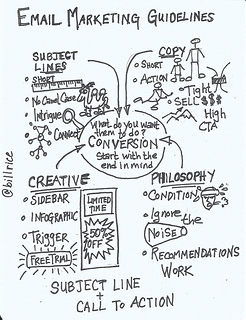While some say that email isn't an effective marketing tool anymore, research shows that it still has the highest ROI of any online marketing tactic.
One reason is that email is still a dominant avenue of communication in business. In fact, 91 percent check their email daily. Email subscriptions to websites for updates and information is growing at the fastest rate ever, with 74 percent of consumers actually preferring to receive commercial communications by email.
We talk with several companies that are doing email marketing, only to find out they’re missing out on some significant opportunities. If you're wondering how your company stacks up, read the checklist below and evaluate your email marketing.
Review your email lists for segmentation opportunities
A common opportunity we uncover is email list segmentation. Companies usually default to using a single email marketing list and offering a monthly newsletter signup.
The problem here is that a one-to-many email message -- especially a newsletter -- isn't relevant for every customer. Every customer does not need every email.
It’s vital that you craft your email marketing lists into the appropriate segments. Rather than just focusing on a monthly newsletter, for example, you may segment a list by actions customers perform on your website. You'd do this so you can hone the message in and make it more relevant.
Segment your audiences based on how the person signed up for the campaign. Did they sign up in the process of downloading a free resource guide? They might be doing their early-stage buying research and need messages crafted towards that purpose.
Send email from a real person's email address
It may seem like common sense to send email marketing campaigns from an administrative or vague email address like “info@,” but you may want to reconsider.
If there's a recognizable name and email address in your email campaign, your open rates will be higher. Use a recognizable name that customers would look forward to getting an email from.
Also, you might want to make sure the email looks like it's coming from a real person instead of over-designing your email. The more personal you can make the email look and sound, the more effective it will be.
Reconsider your subject line
Your subject line is a major factor that determines whether or not subscribers open the email. It needs to be relevant, which is easier to do once you segment your list.
If you don’t have an in-house email marketing copywriter, that’s not a problem (but it might take you more time to find the right words). Spend time researching what makes a great subject line, and then spend time crafting the right subject line for each campaign. Give each email its own time and attention to reap higher open rates overall.
Identify a relevant call to action
Another common email marketing opportunity? Providing a clear, relevant call to action (CTA).
Too often, marketers distract readers with too many options. Ask yourself this question, "What is the one thing you want the reader to do?"
Identify the one action you want a subscriber to take and craft your messaging, graphics, and copy to that single purpose. You can include your social media links and references to recent blog posts, but at the end of the email it should be 100 percent clear what your subscriber should do with that email.
Don't forget mobile
If you aren't checking how your email marketing looks on mobile devices before you send them, you should. While 48 percent of emails are opened on mobile devices, only 11 percent of email marketing campaigns are optimized for mobile devices!
Take time to know your target audience to find out if mobile-optimized email newsletters are right for your business, then plan and design accordingly.
Can you improve your email marketing campaigns? From the email subject to the sender name, every piece of your email marketing campaign matters, so be sure to devote time and resources to each one.









